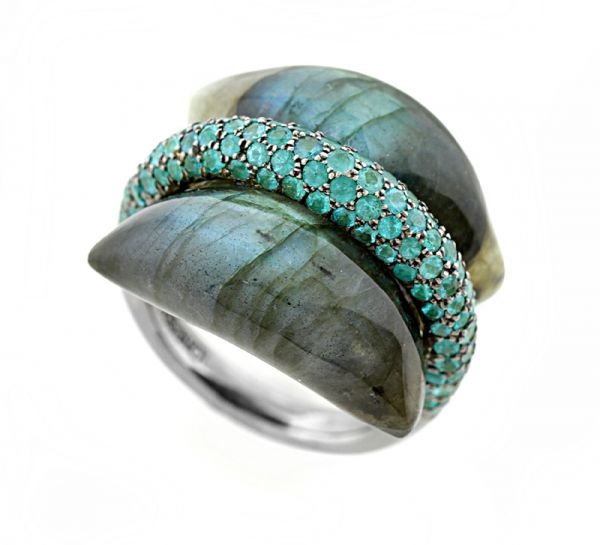
Ion Ionescu: AGTA Award-Winning Jeweler
Santa Fe jeweler Ion Ionescu was awarded the prestigious AGTA Spectrum award for evening-wear jewelry last October. He won for “Pillow for Dreaming,” a palladium and black rhodium ring in which a. 36 ct. carved labradorite and blue Paraiba tourmalines create surface contrast and electric color.
Ionescu, a Romanian-born and -trained jeweler, has lived in Santa Fe for 13 years with his wife, Laila, though he still keeps a studio in New York. He noted in a phone interview, as he was preparing to leave for the Tucson Gem and Mineral Show, that he’d be shopping in the early morning hours for more feldspars and labradorite.
“I buy a lot of rough because I like to carve (the stone). It can be difficult to pick the best (stone) because the surface rough can be impressive, with its bichromial aspects, but when you cut it, you end up with a blank piece.”
 Rough stone on the bench finds Ionescu spending “time to distill the idea that pops up in my head, the image.” Color remains instinctual to him, he said, and is often the way he enters into a piece.
Rough stone on the bench finds Ionescu spending “time to distill the idea that pops up in my head, the image.” Color remains instinctual to him, he said, and is often the way he enters into a piece.
The Brazilian Paraiba mine produces gems of a cuprian electric blue color, named Paraiba tourmaline. The Paraiba stones are considered superior to Nigerian and Mozambique tourmaline, but are rare and difficult to find in large carat weight, because of a decrease in production at the mine since the production boon of the 1990s. Top-quality gemstone, from 1-3 ct. costs $7,200-$23,500 wholesale; $25,000 per carat retail, explains Tom Tiegler. Rarity has meant a doubling in price over the last decade. In 2002, The Gemstone Forecaster reported that in 1990, when Paraiba tourmaline first was offered in Tucson, 2- or 3-carat- sized Paraibas could be purchased for $1000 per carat.That price had vaulted, in ’02, to $10,000 per carat wholesale.
Tiegler’s new Santa Fe gallery, Paragone, at 500 Montezuma, Santa Fe, exhibits work by Ionescu.
Much has clearly changed for the high-design jeweler since the 1990s when Laila Ionescu told the New York Times that in Romania, a working jeweler could never own more than small quantities of precious metal without risking jail. “A jewelry designer could work for the Government producing approved traditional designs but could not legally pursue this art independently without risking imprisonment.”
Ion Ionescu stressed that remaining open to new ideas requires being very open to new influences. “(Jewelry) design comes out of new ideas, looking around,” says Ionescu.

